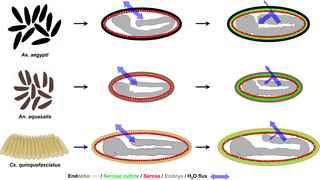PLOS Neglected Tropical Diseases ( IF 3.8 ) Pub Date : 2017-10-30 , DOI: 10.1371/journal.pntd.0006063 Luana C. Farnesi , Helena C. M. Vargas , Denise Valle , Gustavo L. Rezende

|
Mosquito vectors lay their white eggs in the aquatic milieu. During early embryogenesis water passes freely through the transparent eggshell, which at this moment is composed of exochorion and endochorion. Within two hours the endochorion darkens via melanization but even so eggs shrink and perish if removed from moisture. However, during mid-embryogenesis, cells of the extraembryonic serosa secrete the serosal cuticle, localized right below the endochorion, becoming the third and innermost eggshell layer. Serosal cuticle formation greatly reduces water flow and allows egg survival outside the water. The degree of egg resistance to desiccation (ERD) at late embryogenesis varies among different species: Aedes aegypti, Anopheles aquasalis and Culex quinquefasciatus eggs can survive in a dry environment for ≥ 72, 24 and 5 hours, respectively. In some adult insects, darker-body individuals show greater resistance to desiccation than lighter ones. We asked if egg melanization enhances mosquito serosal cuticle-dependent ERD. Species with higher ERD at late embryogenesis exhibit more melanized eggshells. The melanization-ERD hypothesis was confirmed employing two Anopheles quadrimaculatus strains, the wild type and the mutant GORO, with a dark-brown and a golden eggshell, respectively. In all cases, serosal cuticle formation is fundamental for the establishment of an efficient ERD but egg viability outside the water is much higher in mosquitoes with darker eggshells than in those with lighter ones. The finding that pigmentation influences egg water balance is relevant to understand the evolutionary history of insect egg coloration. Since eggshell and adult cuticle pigmentation ensure insect survivorship in some cases, they should be considered regarding species fitness and novel approaches for vector or pest insects control.
中文翻译:

蚊子的深色卵更能抵抗干燥条件:黑色素可增强浆膜角质层对卵抗伊蚊,按蚊和库蚊载体的抗性的作用
蚊子在水生环境中产卵。在早期胚胎发生过程中,水自由通过透明的蛋壳,该蛋壳此时由排卵和内胚层组成。在两个小时内,内胚层通过黑色素变黑,但即使除去水分,卵也会收缩并腐烂。然而,在胚胎中期,胚外浆膜细胞分泌浆膜角质层,位于内膜内膜正下方,成为第三层,也是最内层的蛋壳层。浆膜角质层的形成极大地减少了水的流动,并允许卵在水外生存。卵在晚期胚胎形成过程中的抗干燥能力(ERD)在不同物种之间有所不同:埃及伊蚊,水按蚊和库克斯库克斯库图斯(Culex quinquefasciatus)鸡蛋在干燥的环境中分别可以生存≥72、24和5小时。在某些成虫中,深色身体的个体对干燥的抵抗力要强于浅色个体。我们询问鸡蛋变黑是否增强了蚊浆膜角质层依赖的ERD。在胚胎后期发生ERD较高的物种表现出更多的黑色蛋壳。黑色素化-ERD假设使用两个按蚊按蚊确证菌株,野生型和突变型GORO,分别具有深棕色和金色蛋壳。在所有情况下,浆膜角质层的形成对于建立有效的ERD至关重要,但是蛋壳较深的蚊子在水外的卵生存力要比蛋壳较浅的高得多。色素沉着影响卵水平衡的发现与理解昆虫卵着色的进化历史有关。由于蛋壳和成年表皮色素沉着在某些情况下可确保昆虫存活,因此应考虑它们的物种适应性以及病媒或害虫防治的新方法。



























 京公网安备 11010802027423号
京公网安备 11010802027423号